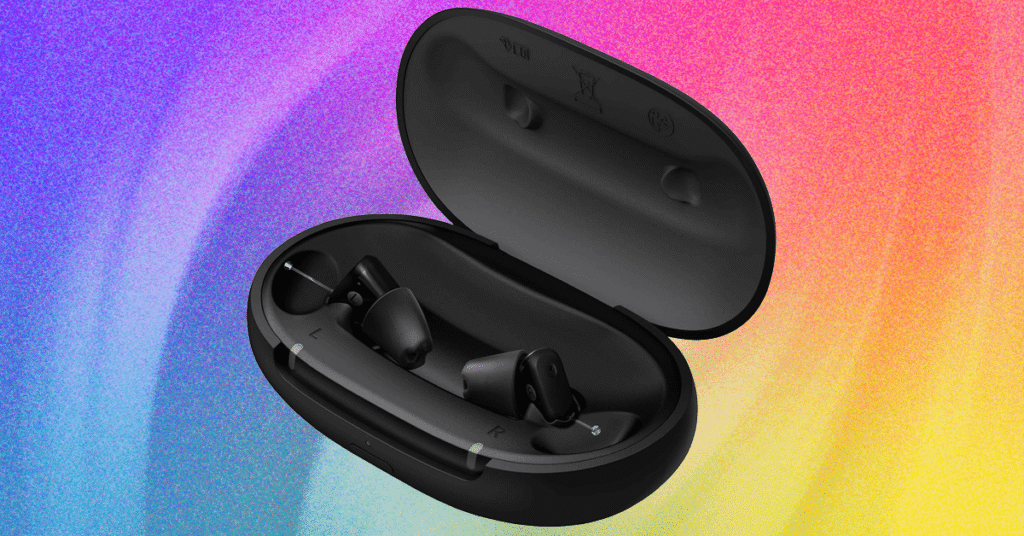Invisible Hearing Aids to Avoid
Invisible or not, the market is becoming saturated with low-quality hearing aids that don’t offer much else besides subtlety. While it’s great that you no longer have to broadcast your hearing loss to everyone in the room, it’s also easy to get lured into the promise of “invisibility” at a low cost. Here are a few invisible hearing aids we don’t fully recommend:
Zepp’s Clarity One (5/10, WIRED Review) look great and weigh just 1.06 grams, but audio quality was poor, featuring an unacceptable level of hiss. Despite epic battery life, these invisible hearing aids aren’t ideal for users who want high-grade hearing support. I encountered similar issues with the slightly larger but more configurable Zepp Clarity Pixie (4/10, WIRED Review).
The Audien Hearing Atom One (5/10, WIRED Review) hearing aids are cheap, subtle, FDA-compliant, and … that’s about it. With the amount of price gouging present in the hearing aid industry, I applaud the Atom One’s sub-$100 price, but the quality just isn’t worth even that low outlay. There are also no smart features on the device, which lacks Bluetooth, a mobile app, or even a charging case.
The Ceretone Core One (5/10, WIRED Review) hearing aids are an over-the-counter offering that also keeps costs low at $350 a pair. They’re arguably the smallest and lightest hearing aids available, but they emit an ear-piercing feedback screech whenever you make even the slightest bit of contact with them, making for an unpleasant user experience. Aside from that, they’re echoey and hard to insert, and the mobile app you’re dependent on to make adjustments is beyond terrible. Unfortunately, things aren’t much better with the newer Ceretone Core One Pro.
How Much Do In-the-Ear Hearing Aids Cost?
Hearing aids are a market in chaos, with price options as low as $100 and as high as $10,000. As expected, prescription in-the-ear and completely-in-canal hearing aids cost way more than over-the-counter models. On average, an prescription device will cost between $2,000 and $8,000, and quality OTCs will run you between $800 and $2,000 a pair. While we’d love to prop up the $100 options that are hitting shelves amid the OTC boom, we’ve yet to find one that treats hearing loss effectively. Here are some options for managing the high costs of hearing aids:
Financing is an option for all the hearing aid brands on this list. For example, the most expensive device we recommend, the prescription Signia Silk 7X, offers 12-month financing with zero percent APR. Several third-party financing companies like Klarna or Care Credit may be helpful.
Insurance may be an option as an add-on to existing coverage. In general, employer-based health plans don’t offer hearing aid reimbursements outright, but supplemental options may be available. Those over the age of 65 can possibly enroll in the add-on Medicare Advantage Plans (Part C) for hearing-related benefits. Medicaid or VA benefits are options as well.
Contact your local state department to see if you qualify for an assistance program that helps pay for your hearing aids. While not all states offer this service, they may be able to direct you to other organizations in your jurisdiction that can.
Most hearing aids come with a warranty and any which do not should be considered with extreme skepticism. Warranty periods vary, but one year is probably the most common: These warranties often cover repairs to damaged hearing aid devices but they do not cover replacement if you lose your hearing aids or destroy them beyond the ability to be repaired.
Some vendors offer extended protection plans at the time of purchase. Jabra, for example, offers its hearing aids with a 3-year warranty that includes access to Jabra’s internal audiologists, providing a better level of service over that period. When shopping for hearing aids, check the fine print: Hearing aids are expensive, so make sure you fully understand the warranty details before you buy. Many hearing aid companies have excellent pre-sales support that can walk you through any questions.
What is Age-Related Hearing Loss (Presbycusis)?
By the age of 70, about two-thirds of Americans will suffer some level of hearing loss strictly related to age (as opposed to damage). It is the most common cause of hearing loss globally. Presbycusis means “old hearing” and it’s most heavily characterized by loss of the ability to understand some of the most common parts of speech. Typically, people with presbycusis will have trouble distinguishing among the so-called “voiceless consonants,” which include p, k, and f sounds, among others. If you have ever had trouble understanding whether someone said “shin” or “chin,” for example, you’re on the right track to knowing what presbycusis feels like.
Not all presbycusis diagnoses are the same. There is a wide range of sub-types of presbycusis physicians can diagnose, including neural presbycusis (related to loss of nerve fibers in the ear) and mechanical presbycusis (due to physical changes to the ear canal). The specific type of presbycusis affecting a patient may encourage a physician to treat them with a different approach or a different type of hearing aid product.
Presbycusis often comes on slowly, and many sufferers only find out about it because a friend or family notes the difficulty the patient is having with hearing. Even routine medical exams are not effective for diagnosing presbycusis. Rather, patients who suspect they may be suffering from presbycusis should consult with their physician.
Power up with unlimited access to WIRED. Get best-in-class reporting and exclusive subscriber content that’s too important to ignore. Subscribe Today.

